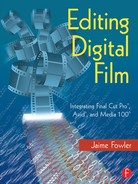The first time I heard about digital nonlinear editing was 1992. An insane visual artist named Adam walked into my video editing room to finish a trailer for his film. He explained to me that he had already cut the trailer offline and that all I had to do was make a few tweaks and assemble the rest.
During the course of our conversation, he kept bugging me about how smoothly the edit had gone. Adam is Hungarian, but the language he spoke was English. Still, I didn’t understand a word of it.
“We cut all of this on an Avid. It works nonlinear. You can make a change just like that!” he exclaimed, snapping his fingers. When we set up to finish the trailer and were checking H/SC phase, Adam said, “You never have to do that in nonlinear.” Every time I did a dissolve, he would say, “Oh, that’s so easy with nonlinear. Just drag and drop.” Every time I had to change a transition and check for H-shifts, he would say, “You don’t have to do that anymore. Not with nonlinear.”
He was really beginning to get on my nerves.
The advent of nonlinear editing systems has opened a lot of doors for editors, particularly with respect to mediums. Thanks to the inventors of NLE technology, video editors can become film editors, film editors can become world wide web developers, world wide web editors can become CD-ROM editors, and so on. These days, the term “editor” can apply to one who is familiar with many mediums and has adapted to many different styles of cutting.
But each medium has its niche, a set of rules that makes it different. And many times, the rules about that particular medium are cast aside, to be learned later as the project proceeds. For example, one could edit a short film for placement on the world wide web, but how do you compress it? Will the website visitors need a plug-in to see it? Which is the best compression technique for the quickest download at the highest quality? It isn’t necessarily important to know these things at the outset of the project, but when the time comes to compress the film and prepare it for the world wide web, it is absolutely essential that the editor has the knowledge to properly adapt the finished cut to that medium.
In the case of filmmaking, there are many rules as well. But some of the rules of filmmaking have to be implemented from the start. If one waits until the edit is completed to learn the particulars of film, the result would prove disastrous. Unlike some mediums, film parameters have to be established from the beginning, because of the adaptation from one medium (film), to another medium (video) and then back to the original medium (film). The initial adaptation doesn’t usually cause any problems. But without a proper set up from the beginning of the project, vital information can be lost, and re-adaptation from video to the original film can prove challenging, or even in some cases, impossible.
It isn’t very difficult to understand how film works, but there are too many methods and means of completing film to list them in brief. Is it a DV film? Is it a 16mm film? Will it be projected in a theater? Electronically or on film? Who will conform the film? What type of numbering system will be used to identify frames of the film? Who will process the film? What about telecine? Who’s the neg cutter? The list of questions could go on and on.
This book is intended for those who want to know how to adapt their nonlinear editing skills to film work. But unlike most books about film, this one is written from a video editor’s perspective. I learned about film much later in my career. As a result, I don’t take as much stock in one particular method of cutting film, as some film editors do. In this book, you’ll learn about how to integrate film with nonlinear editing systems and some helper applications called matchbacks.
If you’re an experienced editor looking for a way to cut films with nonlinear editors, or NLEs, this book is for you. If you’re shooting DV but aren’t sure how to put it on film, this book is for you. If you’re a film editor or director without a clue as to how film and NLEs are integrated, this book is for you. And if you’re a student who is learning nonlinear, but no one in your school has figured out how to use it with film, this book is definitely for you.
Learn how easy and fun it can be. Turn the page.
Jaime Fowler
March 2001
